READY TO GET STARTED?
REQUEST A FREE ESTIMATE
Fill out the form below or call (888) 466-7849 for a free, no-obligation estimate.
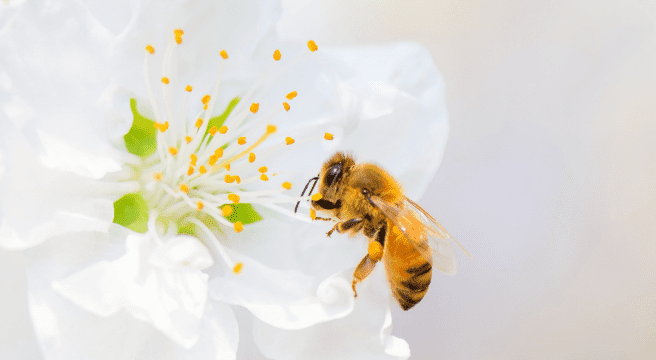
Spring is around the corner, and that means our favorite stinging insects are making a return! Some of these stinging pests are very beneficial for pollinating flowers, but some are not so nice for your home. Check out our list of popular stinging insects in the southeast and what you should know about them!
Bumblebees
Bumblebees are relatively harmless and can be greatly beneficial for pollinating flowers. These insects can be identified by their black and yellow markings and an overall fuzzy appearance. They build their nests out of pollen buildup and will usually build them in the ground or a dense grass clump. If they feel threatened, they can become aggressive and result in stinging, so if the nest is found near a structure, then control may be necessary.
Carpenter Bees
Carpenter bees are often confused with bumblebees, but the top of their abdomen is largely bare and shiny. They are a serious threat to your property, as they burrow deep into wood to make galleries for nurturing their young. Male carpenter bees are territorial, and you may find them hovering in front of your face aggressively, but they have no stinger and these actions are merely for show. Female carpenter bees have a powerful sting which is rarely used.
Honeybees
Honeybees are less than an inch in size and are orange-ish brown or black in color. They are considered social insects and live as colonies in hives, where they can reach sizes up to 80,000 inhabitants. Three types of honeybees live in a beehive: worker, drone, and queen. Each has its important roles and performs specific duties within a bee colony. Honeybees are very beneficial and pollinate 85 percent of food crops intended for human consumption. They are critical to our environment and provide us with honey, which has many positive health benefits.
Yellow Jackets
Yellow jackets are less than an inch in size and are yellow and black in color. These pests reside in nests constructed of paper cartons, which can grow to be the size of a baseball. One nest can contain multiple rounded paper combs which are attached to one another and covered in many layers. Depending on the species, the nest can be near the ground, such as plant roots, logs, or timber; or aerial and attached to shrubs, houses, garages, or sheds. Yellow jackets are slow to sting unless they feel threatened. They are considered beneficial because they control many pest insect species, like flies and aphids.
Remember – it is not recommended to attempt to remove a stinging insect nest on your own and doing so can be extremely dangerous. Instead, work with a local pest control company to access your property and the nest, identify the type of stinging insect (like wasps or other dangerous stingers) and determine the best way to eliminate the threat to your family.

It’s the end of the year and as you put together your list of New Year’s resolutions, some simple home repairs might need to make the cut. What you may not realize is that pests could have been quietly chipping away at your home’s value throughout the year. Here are some things to look for and steps to take to preserve the integrity of your home.
Making these adjustments can help you enjoy your home without the pests and the critters. Reach out to your local pest control company to schedule an inspection and to work out a preventative treatment plan to help keep your home safe.
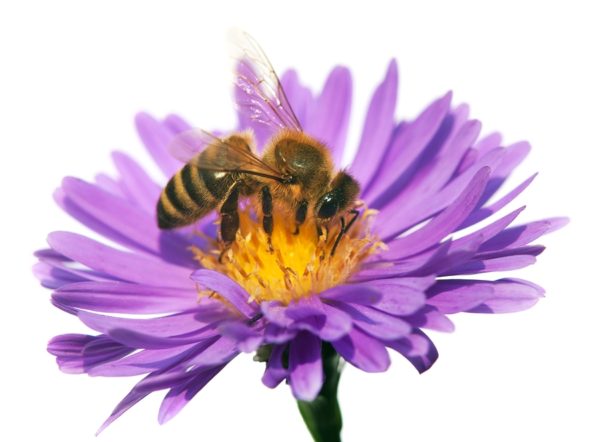
We’ve all been there before… you’re sitting in your house and you hear an incessant buzzing. All of a sudden something flies past your face! If you’re like most of us, your first thought it aghh! A bug in my house! Once you get over the initial shock of being dive bombed by this home invader, your next thoughts might be: What kind of bug is this? Is there more than one? How did it get in my house? How do I get rid of it? While we can’t answer all of your questions, we can help with a few. We’ve listed some of the most common flying pests below, as well as some tips to prevent them from getting into your home.
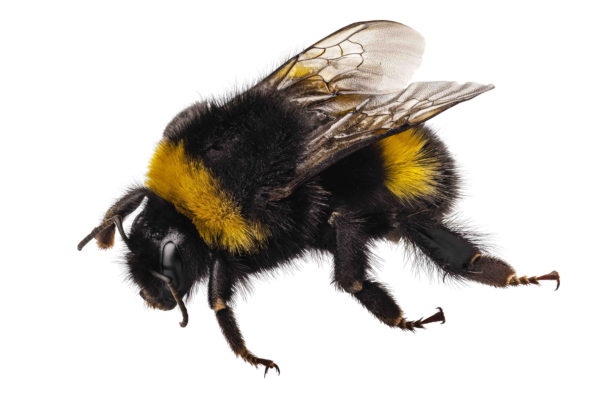
While there are several different species of bees in North America, we are going to look at bumblebees, honeybees, and carpenter bees.
Bumblebees are large, clumsy looking insects with oval shaped bodies. They are extremely fuzzy. They are yellow and black striped in color. They typically grow between 1/4″ and 1″ in length.
Honeybees are predominantly golden yellow with brown bands, but they can also be orange-brown in color. They have a very hairy appearance. They can grow to be about 1/2″ in length. They also have flat hindmost legs which are used to carry pollen.
Carpenter bees have a fuzzy body that is very robust in shape. Their bodies are yellow except for their abdomen which is shiny black. Males also have a white patch on their faces. Carpenter bees grow from 1/2″ to 1″ in length.
Bumblebees typically make their nests underground so their nests may not be visible. They will often make their nests in old mouse burrows or in dense clumps of grass. They have also been known to make their nests under woodpiles or behind the siding of homes. Bumblebees are found throughout the United States.
Honeybees typically make their nests in beehives, trees, hollow logs, and piles of logs. It is very common for them to get inside your home and nest in attics, wall voids, chimneys, and crawlspaces. Honeybees are found throughout the United States.
Carpenter bees create their nests in pieces of wood – preferably soft wood that has not been painted or sealed. They will often make their nests in decks, porches, roof eaves, wooden shingles, wooden playgrounds, in wooden outdoor furniture, and in sheds. The entry holes for carpenter bees are perfectly round.
All three species of bees feed on nectar and pollen from flowering plants. Contrary to popular belief, carpenter bees don’t actually eat the wood they burrow in to make their nests.
Female bumblebees have stingers but males do not. Bumblebees are not significantly aggressive but they will sting if they feel threatened. Their sting can be dangerous to humans with an allergy.
Honeybees are the only bee colonies that can survive for many years. They are very social insects. Female honeybees have stingers but males don’t. The female stinger is barbed which means it is only able to sting once. Honeybees aren’t known for being aggressive but they will sting if they are directly attacked.
Carpenter bees are very solitary insects and don’t create very large nest. Female carpenter bees have stingers but males don’t. Their sting is strong enough to cause a reaction in humans. Female carpenter bees are docile and rarely sting unless they are directly attacked. Male carpenter bees are very aggressive but don’t have stingers to do harm with.
All bees are protected as pollinators so treatment is only provided when they are deemed to be a nuisance or a threat. Removal is always the first treatment option because of this protected status.
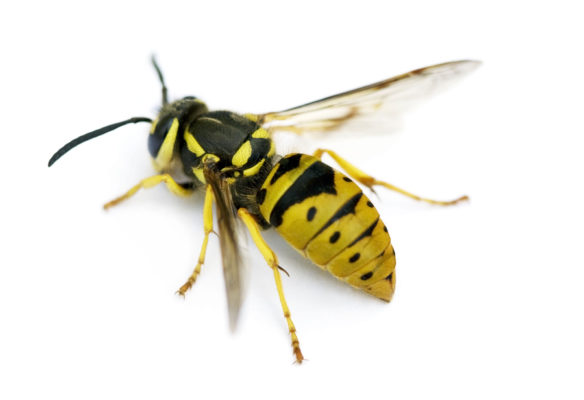
Yellow jackets have a sleek appearance. They are not fuzzy. They are black and yellow striped in color. They can grow to be 3/8″ to 5/8″ long.
Yellow jackets build their nests either high up or in the ground. Their elevated nests can be found in the walls of buildings or in attics and chimneys. Their ground nests are usually in areas that lack vegetation or in spaces next to the entrance of buildings.
Yellow jackets feed on other insects. They also eat any sweets and proteins that they come across. You can often find yellow jackets at outdoor events because they like to feed on sugary food scraps and drinks that are left out.
Yellow jackets have a smooth stinger which allows them to sting multiple times. They are usually docile unless their nests are approached. Then they become very aggressive and will sting repeatedly. Their sting can be life threatening if you are allergic. Yellow jackets are beneficial both as pollinators and because they help control the population of nuisance insects.
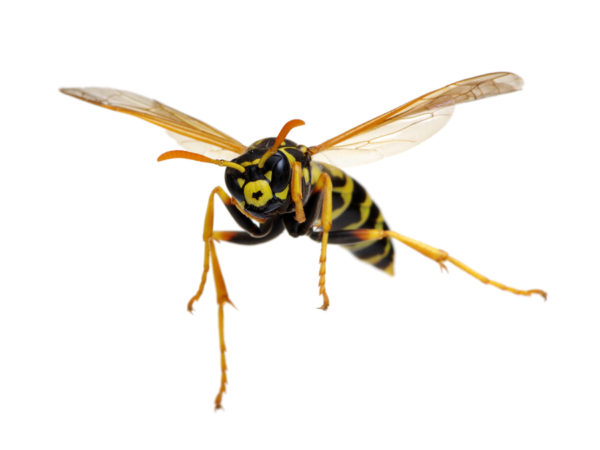
Paper wasps have a sleek appearance with a pinched waste and long, thin legs. They have gray wings and their bodies are black or brown with yellow or orange markings. Paper wasps can grow to be 5/8″ to 3/4″ in length.
Paper wasps are found throughout the United States. They will build their nests of the ground on any horizontal surface they can find. Their nests are commonly found hanging from trees, shrubs, porches, decks, roofs, outdoor grills, and door frames. Their nests resemble an umbrella attached by a stem. Their name comes from the paper-like nests that they build.
Paper wasps are predatory insects and feed on a wide variety of insects and spiders. They also eat nectar and pollen.
Paper wasps have smooth stingers that allow them to sting multiple times. They are not typically aggressive but will sting to defend their nests. Paper wasps have facial recognition capabilities like humans and chimpanzees do. They can actually recognize the faces of their colony members.
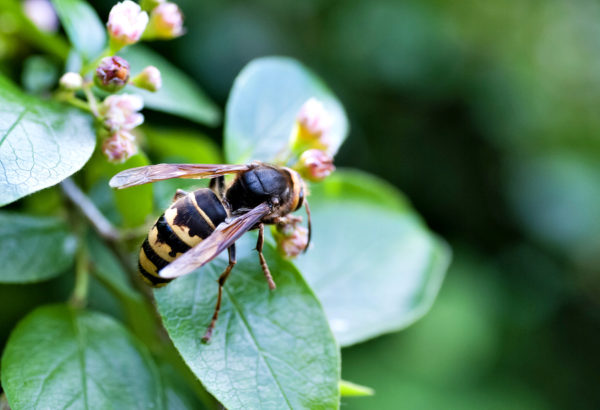
Hornets are much bigger than wasps. They are almost completely black except for an off white pattern on their face. They are long and thin with wasp-like bodies. They can grow from 3/4″ to 1-3/8″ in length.
Hornets are found throughout the United States. Hornet colonies only survive for 1 year. They build aerial nests that can be found in trees, on utility poles, on the side of homes, and under eaves. Hornet nests can be more than 14″ around and more than 24″ long.
Hornets are pollinators. Adults have a liquid diet that mostly consists of nectar and plant juices. They are also predatory and will prey on insects that they bring back to their nests to feed their larvae.
Hornets have a more painful sting than wasps do. A single hornet sting can be fatal if the victim is allergic. When hornets sting or feel threatened, they give off a pheromone that signals the rest of the colony to attack as well.
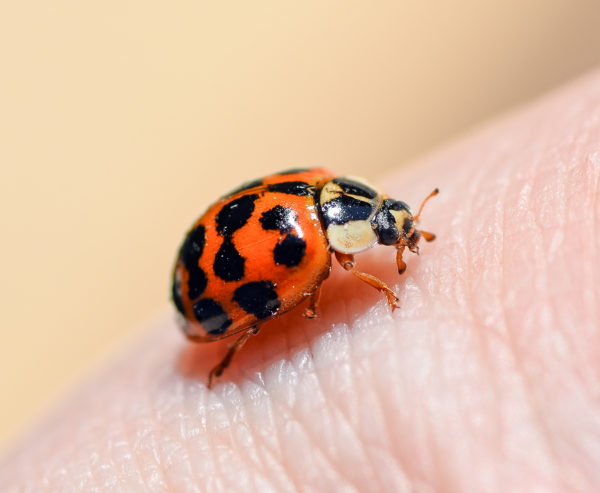
Ladybugs have a distinctive appearance. They are bright red, orange, or yellow with black spots. Their bodies are oval and dome shaped.
Ladybugs are found worldwide. There are over 5000 species total and 450 species in North America. Ladybugs live outside in gardens and landscaped areas. They aren’t able to tolerate cold weather so in the fall they will invade homes in search of a place to overwinter. They will typically gather on windowsills or you will see them crawling along walls. They tend to end up in attics, under flooring, and in wall voids.
Despite their appearance, ladybugs are predatory insects. They feed on a variety of other insects, helping to keep nuisance populations down.
Ladybugs secrete a substance wen they are threatened that makes them taste bad to their predators. They can also play dead if they feel threatened.
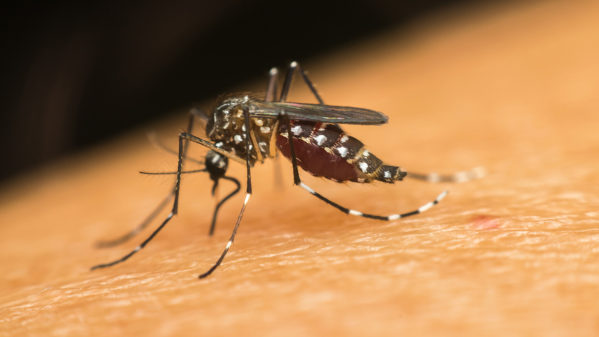
Mosquitoes have narrow bodies with long thin legs and transparent wings. They have gray bodies with white stripes on their abdomen. They also have long beaks that allow them to penetrate the skin. Mosquitoes can grow to be 1/4″ to 3/8″ long.
Mosquitoes can be found in almost every landscape environment on earth with the exception of deserts and the arctic. Mosquitoes are most often found near stagnant water as this is where they lay their eggs. They are often found on the edges of streams, lakes, and ponds; near wading pools; old tires; bird baths; tarps; piles of trash; clogged gutters; and wheelbarrows.
Mosquitoes feed on nectar and plant juices. Female mosquitoes bite to feed on blood.
The species of mosquito determines when they are most active. Some species are more active in the daytime while others become active at dark. Mosquitoes are capable of transmitting several diseases and pathogens to both humans and animals. Mosquitoes can transmit West Nile virus, Zika virus, Chikungunya fever, malaria, and canine heartworm among others.
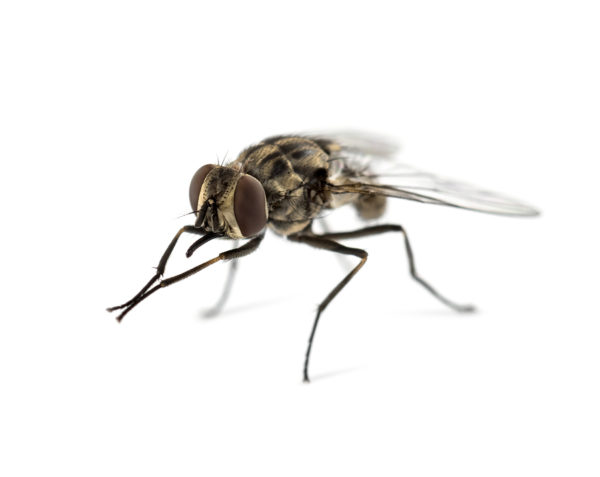
Houseflies have a very distinctive appearance. They have dull gray bodies with vertical lines on the top, a single gold stripe, and a silver stripe on their face. They can grow to be 1/8″ to 1/4″ in size.
Flies can be found in most homes. They enter through tears in screens, gaps around windows and doors, doors and windows that have been left open, and cracks in the foundation. They are attracted to homes by garbage, animal feces, compost piles, and leaky pipes. They will often rest on your floors, walls, and ceilings.
Houseflies are scavengers that eat a variety of different foods. They will feed on food found in pantries and kitchens, pet food, carcasses, garbage, or excrement. Houseflies are only able to eat liquids but they are able to turn many solid foods into liquid form so that they can eat it.
Houseflies can spread diseases when they land on your food or your food prep areas. They are the most common fly found in homes and only live from 15 to 25 days.
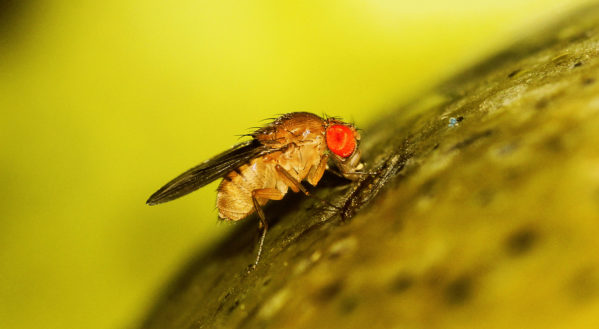
Fruit flies are extremely small in size, only getting about 1/8″ in length. They are usually brown, tan or black with distinctive red eyes. They are too small, however, for you to determine their color with the naked eye.
Fruit flies are found throughout the United States. They are usually seen in the kitchen, especially around fruits and vegetables. They live outside in spring and summer. They enter homes as hitchhikers on fruits and vegetables that we buy from stores that are already infested. They can also enter through small spaces in widows, doors, and walls. They are attracted by large gardens, compost piles, and fruit trees.
Fruit flies feed on very ripe fruits and vegetables like bananas, strawberries, melons, cucumbers, potatoes, and more. They also feed on fermented liquids like vinegar, cider, and beer.
Fruit flies are a nuisance. They enter your home in large numbers and are very difficult to eliminate. They can carry dangerous that can be transmitted to humans.
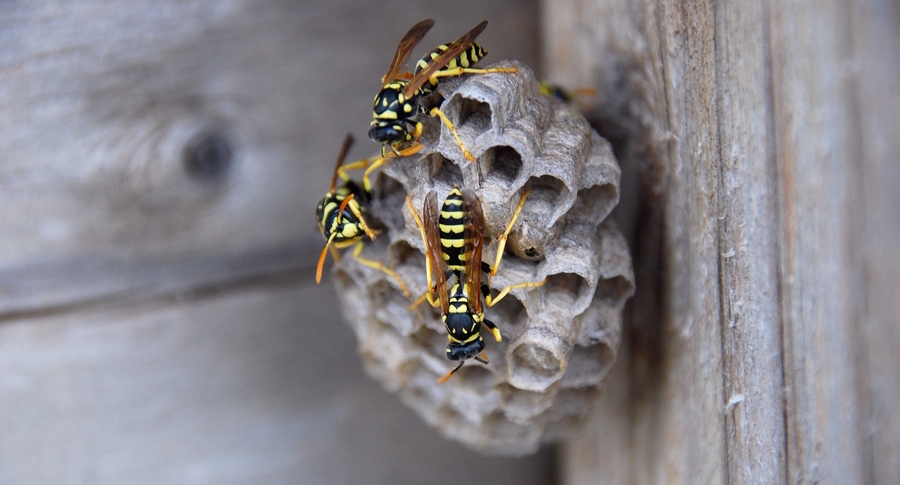
[vc_row css=”.vc_custom_1461783466399{margin-bottom: 20px !important;}”][vc_column][vc_column_text]
Now that we’re well into the Spring season, you may be noticing an influx of pests that were hiding out over the winter – mosquitoes, ants, termites, and BEES. While some bees you’ll encounter are harmless, others can seem threatening and leave behind painful stings and cause allergic reactions. Here’s a list of common bees in the South to be on the lookout during the Spring and Summer seasons, with bee control tips:
[/vc_column_text][/vc_column][/vc_row][vc_row css=”.vc_custom_1461783788041{margin-bottom: 20px !important;}”][vc_column][vc_row_inner][vc_column_inner][ctitle title=”Carpenter Bees” uppercase=”no” background=”#ffffff” font_size=”26″ position=”left” separator_color=”#ffffff”][/vc_column_inner][/vc_row_inner][vc_separator style=”blank” padding_top=”5″ padding_bottom=”5″][vc_row_inner][vc_column_inner width=”1/3″][vc_single_image image=”15376″ img_size=”300×155″ style=”vc_box_outline” img_link_target=”_blank” link=”https://www.callnorthwest.com/identify-pest/bees/carpenter-bees/”][/vc_column_inner][vc_column_inner width=”2/3″][vc_column_text]
Carpenter bees are large black and yellow bees, often mistaken for bumble bees. You’re likely to see them in the Spring hovering around the eaves of your house or under and around decks and porches. Carpenter bees can cause damage to structures by creating small, circular holes as entry points into nests with multiple tunnels, leaving behind trails of sawdust. Any area of exposed wood can be a target for carpenter bee nests. The good news: carpenter bees rarely sting unless bothered; males do not have a stinger but can become aggressive towards other bees, animals or people near their nest and females usually only sting when extremely agitated. You can also prevent carpenter bees from nesting by treating or painting any exposed wood. If you’re already seeing carpenter bee nests, each nest hole should be treated with a pesticide if bees are inside the nest. If no bees are in the nest, seal or paint entry holes. For best results, call a pest control company that specializes in bee control and removal.
[/vc_column_text][/vc_column_inner][/vc_row_inner][/vc_column][/vc_row][vc_row css=”.vc_custom_1461783795963{margin-bottom: 20px !important;}”][vc_column][vc_row_inner][vc_column_inner][ctitle title=”Cicada Killer Bees” uppercase=”no” background=”#ffffff” font_size=”26″ position=”left” separator_color=”#ffffff”][/vc_column_inner][/vc_row_inner][vc_separator style=”blank” padding_top=”5″ padding_bottom=”5″][vc_row_inner][vc_column_inner width=”1/3″][vc_single_image image=”15377″ img_size=”300×155″ style=”vc_box_outline” img_link_target=”_blank” link=”https://www.callnorthwest.com/identify-pest/bees/cicada-killer-bees/”][/vc_column_inner][vc_column_inner width=”2/3″][vc_column_text]
Cicada killer bees are large bees, black or rusty-colored with yellow markings, that resemble a larger version of a yellow jacket. Unlike a lot of other bee species, cicada killer bees do not live in colonies and prefer to nest underground in areas of bare ground. Female cicada killer bees dig burrows 1/2″ in diameter that can extend up to 10″ deep which can cause significant lawn damage. You’re likely to encounter cicada killer bees in the Summer – usually July and August – when they emerge from burrows.
[/vc_column_text][/vc_column_inner][/vc_row_inner][/vc_column][/vc_row][vc_row css=”.vc_custom_1461783803707{margin-bottom: 20px !important;}”][vc_column][vc_row_inner][vc_column_inner][ctitle title=”Bumble Bees” uppercase=”no” background=”#ffffff” font_size=”26″ position=”left” separator_color=”#ffffff”][/vc_column_inner][/vc_row_inner][vc_separator style=”blank” padding_top=”5″ padding_bottom=”5″][vc_row_inner][vc_column_inner width=”1/3″][vc_single_image image=”15378″ img_size=”300×155″ style=”vc_box_outline”][/vc_column_inner][vc_column_inner width=”2/3″][vc_column_text]
While relatively harmless bees, bumble bees – identified by their fuzzy, black and yellow-striped appearance and a buzzing sound while flying – can become aggressive and sting if their nest is threatened. They’re normally seen in flowering plants and typically don’t nest in structures.
[/vc_column_text][/vc_column_inner][/vc_row_inner][/vc_column][/vc_row][vc_row css=”.vc_custom_1461783813281{margin-bottom: 20px !important;}”][vc_column][vc_row_inner][vc_column_inner][ctitle title=”Yellow Jackets” uppercase=”no” background=”#ffffff” font_size=”26″ position=”left” separator_color=”#ffffff”][/vc_column_inner][/vc_row_inner][vc_separator style=”blank” padding_top=”5″ padding_bottom=”5″][vc_row_inner][vc_column_inner width=”1/3″][vc_single_image image=”15379″ img_size=”300×155″ style=”vc_box_outline”][/vc_column_inner][vc_column_inner width=”2/3″][vc_column_text]
Yellow jackets are one of the most commonly encountered bees and also one of the most aggressive. Their stings can be extremely painful and cause severe allergic reactions for some. Yellow jackets are also know to sting repeatedly. Avoiding yellow jackets is the best method of sting prevention or remain still if you encounter them; swatting or sudden movements can cause them to attack.
[/vc_column_text][/vc_column_inner][/vc_row_inner][/vc_column][/vc_row][vc_row css=”.vc_custom_1461783821501{margin-bottom: 20px !important;}”][vc_column][vc_row_inner][vc_column_inner][ctitle title=”Paper Wasps” uppercase=”no” background=”#ffffff” font_size=”26″ position=”left” separator_color=”#ffffff”][/vc_column_inner][/vc_row_inner][vc_separator style=”blank” padding_top=”5″ padding_bottom=”5″][vc_row_inner][vc_column_inner width=”1/3″][vc_single_image image=”15381″ img_size=”300×155″ style=”vc_box_outline”][/vc_column_inner][vc_column_inner width=”2/3″][vc_column_text]
Paper wasps are large, aggressive wasps that cause painful bites and sometimes severe allergic reactions. They’re most likely to sting if their nest is threatened or disturbed. It’s recommended to contact an exterminating company for wasp nest removal.
[/vc_column_text][/vc_column_inner][/vc_row_inner][/vc_column][/vc_row][vc_row css=”.vc_custom_1461783548104{margin-bottom: 40px !important;}”][vc_column][vc_row_inner][vc_column_inner][ctitle title=”Hornets” uppercase=”no” background=”#ffffff” font_size=”26″ position=”left” separator_color=”#ffffff”][/vc_column_inner][/vc_row_inner][vc_separator style=”blank” padding_top=”5″ padding_bottom=”5″][vc_row_inner][vc_column_inner width=”1/3″][vc_single_image image=”15382″ img_size=”300×155″ style=”vc_box_outline”][/vc_column_inner][vc_column_inner width=”2/3″][vc_column_text]
Hornets are brown and yellow striped with reddish colored wings, and sometime mistaken for cicada killer bees. They build above-ground nests, usually in trees, and are active in the Spring. It’s recommended that you contact a pest control company to remove a hornet nest, but they do not pose a serious threat to humans and will die or hibernate in the Fall.
[/vc_column_text][/vc_column_inner][/vc_row_inner][/vc_column][/vc_row]

[vc_row css=”.vc_custom_1461783466399{margin-bottom: 20px !important;}”][vc_column][vc_column_text]
Now that we’re well into the Spring season, you may be noticing an influx of pests that were hiding out over the winter – mosquitoes, ants, termites, and BEES. While some bees you’ll encounter are harmless, others can seem threatening and leave behind painful stings and cause allergic reactions. Here’s a list of common bees in the South to be on the lookout during the Spring and Summer seasons, with bee control tips:
[/vc_column_text][/vc_column][/vc_row][vc_row css=”.vc_custom_1461783788041{margin-bottom: 20px !important;}”][vc_column][vc_row_inner][vc_column_inner][ctitle title=”Carpenter Bees” uppercase=”no” background=”#ffffff” font_size=”26″ position=”left” separator_color=”#ffffff”][/vc_column_inner][/vc_row_inner][vc_separator style=”blank” padding_top=”5″ padding_bottom=”5″][vc_row_inner][vc_column_inner width=”1/3″][vc_single_image image=”15376″ img_size=”300×155″ style=”vc_box_outline” img_link_target=”_blank” link=”https://www.callnorthwest.com/identify-pest/bees/carpenter-bees/”][/vc_column_inner][vc_column_inner width=”2/3″][vc_column_text]
Carpenter bees are large black and yellow bees, often mistaken for bumble bees. You’re likely to see them in the Spring hovering around the eaves of your house or under and around decks and porches. Carpenter bees can cause damage to structures by creating small, circular holes as entry points into nests with multiple tunnels, leaving behind trails of sawdust. Any area of exposed wood can be a target for carpenter bee nests. The good news: carpenter bees rarely sting unless bothered; males do not have a stinger but can become aggressive towards other bees, animals or people near their nest and females usually only sting when extremely agitated. You can also prevent carpenter bees from nesting by treating or painting any exposed wood. If you’re already seeing carpenter bee nests, each nest hole should be treated with a pesticide if bees are inside the nest. If no bees are in the nest, seal or paint entry holes. For best results, call a pest control company that specializes in bee control and removal.
[/vc_column_text][/vc_column_inner][/vc_row_inner][/vc_column][/vc_row][vc_row css=”.vc_custom_1461783795963{margin-bottom: 20px !important;}”][vc_column][vc_row_inner][vc_column_inner][ctitle title=”Cicada Killer Bees” uppercase=”no” background=”#ffffff” font_size=”26″ position=”left” separator_color=”#ffffff”][/vc_column_inner][/vc_row_inner][vc_separator style=”blank” padding_top=”5″ padding_bottom=”5″][vc_row_inner][vc_column_inner width=”1/3″][vc_single_image image=”15377″ img_size=”300×155″ style=”vc_box_outline” img_link_target=”_blank” link=”https://www.callnorthwest.com/identify-pest/bees/cicada-killer-bees/”][/vc_column_inner][vc_column_inner width=”2/3″][vc_column_text]
Cicada killer bees are large bees, black or rusty-colored with yellow markings, that resemble a larger version of a yellow jacket. Unlike a lot of other bee species, cicada killer bees do not live in colonies and prefer to nest underground in areas of bare ground. Female cicada killer bees dig burrows 1/2″ in diameter that can extend up to 10″ deep which can cause significant lawn damage. You’re likely to encounter cicada killer bees in the Summer – usually July and August – when they emerge from burrows.
[/vc_column_text][/vc_column_inner][/vc_row_inner][/vc_column][/vc_row][vc_row css=”.vc_custom_1461783803707{margin-bottom: 20px !important;}”][vc_column][vc_row_inner][vc_column_inner][ctitle title=”Bumble Bees” uppercase=”no” background=”#ffffff” font_size=”26″ position=”left” separator_color=”#ffffff”][/vc_column_inner][/vc_row_inner][vc_separator style=”blank” padding_top=”5″ padding_bottom=”5″][vc_row_inner][vc_column_inner width=”1/3″][vc_single_image image=”15378″ img_size=”300×155″ style=”vc_box_outline”][/vc_column_inner][vc_column_inner width=”2/3″][vc_column_text]
While relatively harmless bees, bumble bees – identified by their fuzzy, black and yellow-striped appearance and a buzzing sound while flying – can become aggressive and sting if their nest is threatened. They’re normally seen in flowering plants and typically don’t nest in structures.
[/vc_column_text][/vc_column_inner][/vc_row_inner][/vc_column][/vc_row][vc_row css=”.vc_custom_1461783813281{margin-bottom: 20px !important;}”][vc_column][vc_row_inner][vc_column_inner][ctitle title=”Yellow Jackets” uppercase=”no” background=”#ffffff” font_size=”26″ position=”left” separator_color=”#ffffff”][/vc_column_inner][/vc_row_inner][vc_separator style=”blank” padding_top=”5″ padding_bottom=”5″][vc_row_inner][vc_column_inner width=”1/3″][vc_single_image image=”15379″ img_size=”300×155″ style=”vc_box_outline”][/vc_column_inner][vc_column_inner width=”2/3″][vc_column_text]
Yellow jackets are one of the most commonly encountered bees and also one of the most aggressive. Their stings can be extremely painful and cause severe allergic reactions for some. Yellow jackets are also know to sting repeatedly. Avoiding yellow jackets is the best method of sting prevention or remain still if you encounter them; swatting or sudden movements can cause them to attack.
[/vc_column_text][/vc_column_inner][/vc_row_inner][/vc_column][/vc_row][vc_row css=”.vc_custom_1461783821501{margin-bottom: 20px !important;}”][vc_column][vc_row_inner][vc_column_inner][ctitle title=”Paper Wasps” uppercase=”no” background=”#ffffff” font_size=”26″ position=”left” separator_color=”#ffffff”][/vc_column_inner][/vc_row_inner][vc_separator style=”blank” padding_top=”5″ padding_bottom=”5″][vc_row_inner][vc_column_inner width=”1/3″][vc_single_image image=”15381″ img_size=”300×155″ style=”vc_box_outline”][/vc_column_inner][vc_column_inner width=”2/3″][vc_column_text]
Paper wasps are large, aggressive wasps that cause painful bites and sometimes severe allergic reactions. They’re most likely to sting if their nest is threatened or disturbed. It’s recommended to contact an exterminating company for wasp nest removal.
[/vc_column_text][/vc_column_inner][/vc_row_inner][/vc_column][/vc_row][vc_row css=”.vc_custom_1461783548104{margin-bottom: 40px !important;}”][vc_column][vc_row_inner][vc_column_inner][ctitle title=”Hornets” uppercase=”no” background=”#ffffff” font_size=”26″ position=”left” separator_color=”#ffffff”][/vc_column_inner][/vc_row_inner][vc_separator style=”blank” padding_top=”5″ padding_bottom=”5″][vc_row_inner][vc_column_inner width=”1/3″][vc_single_image image=”15382″ img_size=”300×155″ style=”vc_box_outline”][/vc_column_inner][vc_column_inner width=”2/3″][vc_column_text]
Hornets are brown and yellow striped with reddish colored wings, and sometime mistaken for cicada killer bees. They build above-ground nests, usually in trees, and are active in the Spring. It’s recommended that you contact a pest control company to remove a hornet nest, but they do not pose a serious threat to humans and will die or hibernate in the Fall.
[/vc_column_text][/vc_column_inner][/vc_row_inner][/vc_column][/vc_row]